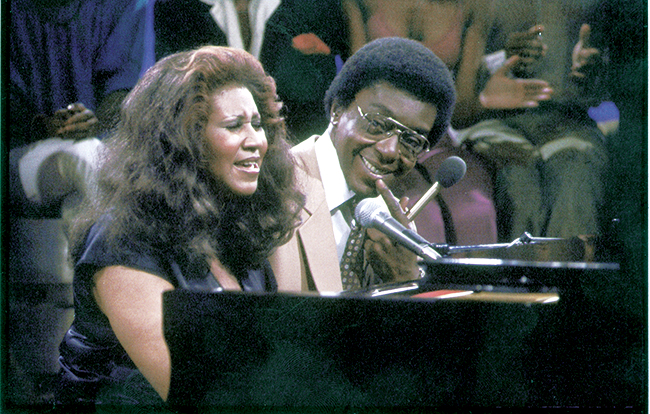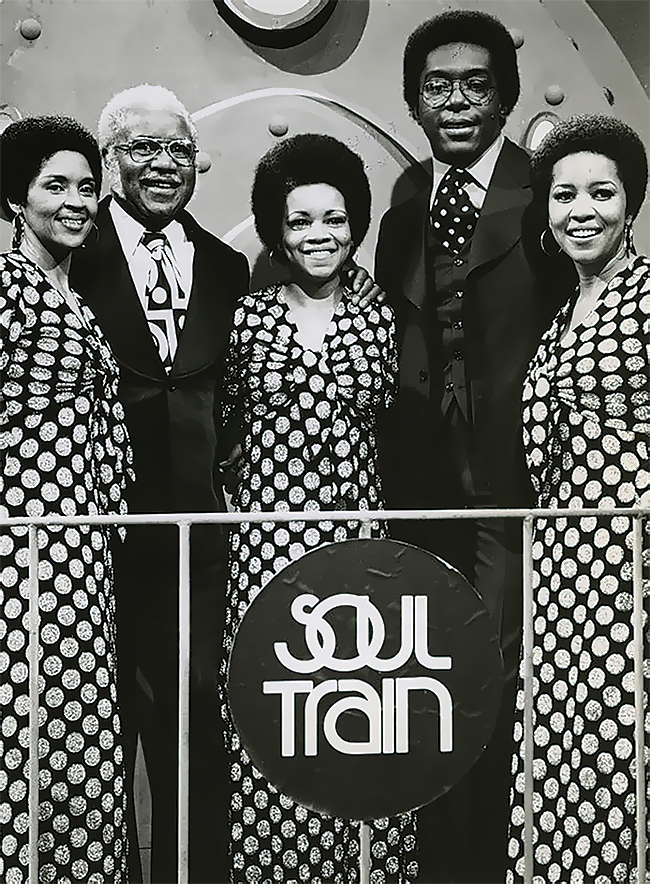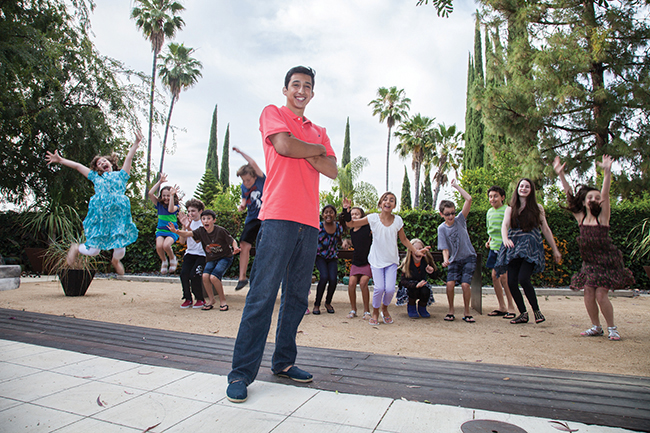
Peace, Love & Soul: The Legacy and Final Sign-Off of Don Cornelius
The amazing story of how a self-made entrepreneur took a small UHF show in Chicago and transformed it into an American cultural phenomenon, ultimately helping push black music into the mainstream. But no amount of trailblazing or success provided peace in Don Cornelius’ golden years, which were tragically cut short at his Sherman Oaks home.
-
CategoryPeople
-
Written byMichael Ventre
For all his funky elegance, for all his suave sense of dignity, Don Cornelius—pioneer, entrepreneur and icon of the African-American musical landscape—had one hideous golf swing. “Oh my God, he made Charles Barkley look like Tiger Woods,” says Ron del Barrio, his occasional instructor at Weddington Golf & Tennis on Whitsett Avenue in Studio City. (And by the way, for readers who have never seen NBA great Barkley swing a golf club, that’s not a compliment.)
“I can’t explain it,” del Barrio adds. “I wouldn’t call it a backswing. He would take the club halfway back, he’d stop, he’d look at his hands, look at his arms, turn his head back to the ball and finish his backswing and stop at the top. And he’d pull his arms down like he was ringing a bell with no legs—and get it airborne one in eight shots. And he couldn’t care less. He’d stay there for two or three hours and enjoy the crap out of it.”
Cornelius arrived at the public driving range and par-3 course usually in the morning, sometimes alone or sometimes with his son Tony. He’d park his yellow Rolls Royce, saunter in wearing the same casual, black outfit, chitchat with the pros and the duffers, find an open stall and begin wailing away at buckets of dimpled spheres.
At Weddington, there was no “Soul Train” chugging by. No James Brown, Barry White, The O’Jays, Aretha Franklin or Parliament-Funkadelic. There were no negotiations to be handled, no sound checks to be taken, no dancers to be costumed and choreographed.
Make no mistake: The man who created Soul Train, the syndicated television show that broadened the landscape for soul, R&B and funk, loved that world too—with all his heart. But the driving range on Whitsett was a sanctuary. Golf was a spiritual force.
“He really enjoyed going to the driving range and spending the afternoon hitting golf balls,” remembers Tony Cornelius, who grew up in Chicago along with his brother Raymond, living with Don’s first wife, Delores. “Or driving his car around the city. He went there for years. He introduced me to Whitsett as well.”
 However, outside of that neighborly golf emporium where he was just one of the guys, Don Cornelius was a towering figure who made television history. Born and raised in Chicago, the Korean war veteran worked at various jobs before taking a broadcasting course and landing a position as a disc jockey.
However, outside of that neighborly golf emporium where he was just one of the guys, Don Cornelius was a towering figure who made television history. Born and raised in Chicago, the Korean war veteran worked at various jobs before taking a broadcasting course and landing a position as a disc jockey.
Ideas converged when he moved to a Chicago TV station, and his love for music and dance led to the creation of a TV show that had never before been on American television: a music and dance show that was predominantly African-American—from the host to the dancers to most of the music. Soul Train, the local incarnation, debuted in 1970.
Just one year later, another first: Soul Train became syndicated—the first time ever for a show created and owned by an African-American. Now available for purchase by TV operations all over the country, Soul Train moved its operations to Los Angeles.
“I think he knew he had started off with a pretty humble vision,” muses Kenard Gibbs, whose company MadVision Entertainment purchased Soul Train in 2008. “He endured the trials and tribulations of the television landscape and the cultural changes, and endured various changes of popular music. I think over time he began to understand that he was definitely at the forefront of that.”
Nelson George, author of the book The Hippest Trip in America: Soul Train and the Evolution of Culture and Style, writes that Soul Train was “both one of the longest-running shows in television history and an iconic cultural touchstone for folks not born during its heyday. Somehow Soul Train has soaked into the DNA of our pop culture.”
Cornelius himself saw it from a more practical standpoint. He told George, “People look at Soul Train on its surface and assume that it was a tremendous challenge—that it was real hard and it was almost impossible, and you almost had to kill somebody. But it wasn’t—it wasn’t any of that. Television again is a medium where if you come up with a good enough idea, it just goes right on.”
And “just go right on” it did. Soul Train and Cornelius had a prosperous and vibrant run of 22 years. “He always used to say, ‘Find a need and serve it.’ That was his mantra,” Tony Cornelius recalls. “He enjoyed serving that need.”
What was that need exactly? If audiences wanted to see music on television, they could tune in to Dick Clark’s American Bandstand, which offered a broad menu of artists including African-Americans like Smokey Robinson, Chubby Checker, Fats Domino, Johnny Mathis and Tina Turner. (Clark briefly challenged Soul Train with another show called Soul Unlimited in 1973, but it ended after a few episodes.)
George believes that for Cornelius, timing was key. “He came out of Chicago at the time of soul music and the burgeoning of funk,” he explains. “Late ‘60s, ‘71, ‘72, ‘73, ‘74. R&B got way more ambitious. People like Sly and the Family Stone. Isaac Hayes. It was a prime, prime time for soulful black expression. When most people think of Soul Train, they think of that ’71 to ’74 period.”
Tony Cornelius says his father had loftier goals—beyond music. “He wanted to present a positive image,” Tony explains. “He grew up at a time when positive images for African-Americans were not something that was broadcast. It was more images that weren’t so positive. He decided to do something that clearly put us in a light where others could say, ‘Here are other sides to these people; here’s a way that I can do something different.’ That was his main focus.”

George cites Cornelius as a pioneer of “black capitalism,” recounting in his book the time Cornelius finally landed the elusive James Brown as a guest on Soul Train. Upon arrival, Brown gazed around the show’s set and asked Cornelius three times, “Brother, who is backing you on this?” or “Brother, who’s really behind this?” And Cornelius would reply, “James, it’s just me.”
The singer had a difficult time fathoming that white ownership wasn’t lurking somewhere in the background. Brown, like many others, came to realize that Cornelius’ successful stewardship of Soul Train was not just from a love of music but also the result of a savvy, innovative and groundbreaking business strategy.
“When it went into syndication, that was basically the result of him partnering with Johnson products (makers of Afro Sheen), which was a black hair care company,” notes Gibbs, who ultimately developed a friendship with Cornelius. “It’s very akin today to what we call branded entertainment.”
He continues, “It was total integration. They were not only advertising sponsors, but the dancers served as models both in print ads and television commercials for the hair care company. So it was totally organic integration into the show. And that was back in 1970. He was definitely ahead of his time.”
Don Cornelius was also the essence of cool. Tall, reserved, with an Afro that grew or shrank with the times and lapels on his suits wide enough to conceal Barry White, he cut a figure as stylish and hip as any of his guest artists. And that’s saying something.
Soul Train served as either a launching pad or a fueling station for such notable acts as The O’Jays, The Jackson 5, Aretha Franklin, Marvin Gaye, Al Green, Patti LaBelle, The Isley Brothers, Diana Ross, The Staple Singers, The Main Ingredient, Stevie Wonder, Mary Wells and many, many others. It introduced the public to dancers like Rosie Perez and Jodie Watley, who went on to bigger things.
Cornelius’ approach was not only to put on the best acts he could find but to make sure they were at their best. “Barry traveled with a full orchestra back then,” George shares. Barry White wanted all his musicians to appear on Soul Train with him. That would have scared off most bean-counter show producers. But Cornelius sprung for the added cost.
Cornelius also bucked the lip-synch trend. “It was his willingness to do something different,” George says. “Back then you lip-synched the song. The bandleader controls the show. If you have a live band and you’re not lip-synching, it’s hard to cut out of the band in mid-song on television. Lip-synching was a way to control how the song sounded and how it ended. But Don didn’t care.”
“By allowing them to do their thing, he made the show special,” Nelson adds. “It was different than anything else on TV. It was part of what made the show work. It was a bold choice. It has proven to be an historic choice.”
Cornelius hosted the nationally syndicated Soul Train from 1971 until 1993, when he handed off the mike to others, although he continued to run the program behind the scenes. In 2008 he got out, selling the rights to the show’s library, which until then he had fiercely protected. He continued to pursue other related Soul Train projects, which included his participation in a well-received VH1 documentary.
While Cornelius projected an image of cool success and quiet distinction, beneath the surface there was internal unrest. On February 1, 2012, less than four years after he relinquished the brand that made him rich and famous and after a period of semi-retirement, Cornelius was found dead inside his home on Mulholland in Sherman Oaks. It was a self-inflicted gunshot wound. He did not leave a suicide note.
Throughout his world, the same thought circulated simultaneously: What would cause a man who made such an impact on his own business, and on his own culture, to take his own life? Reports circulated that Cornelius suffered from debilitating seizures as the result of a brain aneurysm and corrective surgery in 1982, and the increased difficulty of controlling them with medication led to a severe depression.
“We all have pain in some way, whether it be physical pain or mental pain,” says Tony, who now runs The Don Cornelius Foundation, a nonprofit that lends support to those contemplating suicide and to the families of those who have committed suicide. “The more I talk about it, the more I think about what we do to relieve our pain. Some people take medication. Some people just hold on until it wears off. Some people unfortunately take their own life.”
By 2009 Cornelius had divorced his second wife, Russian model Viktoria Chapman Cornelius, and was living alone in his hilltop home. The previous year, Cornelius was arrested on charges of domestic violence and was placed on 36 months of probation.
“They had a rough ending,” George says. “They had the police at the house on a couple of occasions. It wasn’t good. It ended really badly, their relationship. And that had to have affected his self-image, there’s no doubt about it.”
Shares Tony, “You go through divorce. You go through business. You go through health issues. I can’t particularly put my finger on one thing or another, because it wouldn’t be fair to do that.” There is always the idea that, no matter how many admirers approach you at Spago or at the golf course or on the street, a man’s perception of himself is the one that matters most.
“When you start comparing yourself to the best, and the best seems to be that much further away, you’re always racing to the top,” Tony says. “I kind of think in his mind he didn’t feel that he was really appreciated. I think it’s that feeling successful people get, or trailblazers get, when they’re after something. It’s like reaching for straws. It’s just hard to explain. I don’t think he felt he was doing all that was possible, and obviously a lot had to do with opportunities. I’m sure he would have liked to be winning Oscars or all kinds of awards. But I don’t think he was really that satisfied.”
In the case of Don Cornelius, the answer may be more common than the specific maladies or court documents might suggest. What drove him to end his life might be more universal than seizures or failed marriages.
“I remember when he came to me once—and I’ve never shared this with a reporter before—and he said, ‘You know, Tony, the things I like to do most are to hit my golf balls and drive my car, and now I can’t do that’ … because he had gotten a lot weaker,” Tony explains. “I said, ‘Dad, hitting golf balls and driving your car are not a big deal.’ But later on as I thought about it, I realized it was a big deal to him.”
At Weddington—or “Whitsett,” as many regulars call it—not much has changed. Perplexed students take instruction from del Barrio and his colleagues. The stalls are occupied by seasoned golfers and green newbies, smashing balls toward the make-believe fairway beyond and fantasizing about someday seeing their names on leaderboards.
Del Barrio recalls, “When he started coming in once a week or once a month, it was like, ‘Are you okay?’ I was taken aback because he was such a regular there. He would say, ‘Look, baby, don’t worry about me. I’m fine.’”
He continues, “He never let on about anything. That’s what killed us all. He never changed. He never let on that there was something wrong. Every time he showed up, that smile just came on. That was it. That’s why everybody was so surprised when it happened—because there’s no way he let on to anything.”
Leaving without last words was not like Don Cornelius. It probably would have been fitting if he left those who knew him or were influenced by him with one last catchphrase.
He had a couple. One was, “You can bet your last money, it’s all gonna be a stone gas, honey.” Another of a farewell vein was, “As always in parting, we wish you love, peace and soul!”
For all his accomplishments, the one thing that he was terrible at—golf— probably meant the most to him. “We always had a laugh, because he always knew that I knew,” del Barrio says. “That’s what we shared. That he sucked and he’d never get better, and he didn’t give a shit. I would look at him, and he’d say, ‘Ah shut up, don’t say it.’ It was just fun.”
Architect May Sung Comes to The Rescue on a Studio City Reno Gone Wild
In the right hands…finally!











